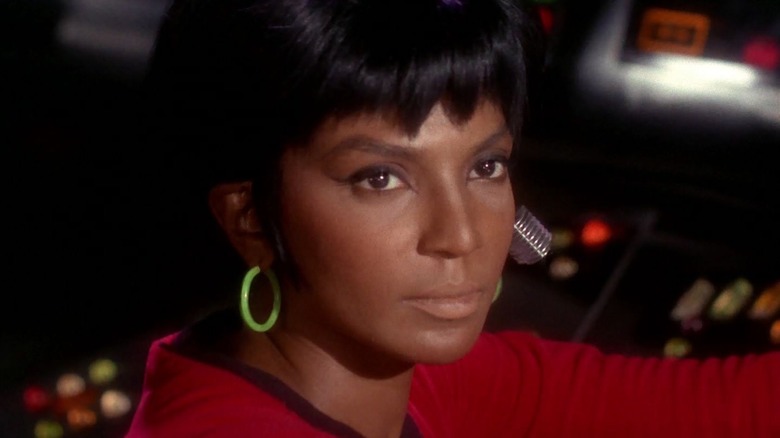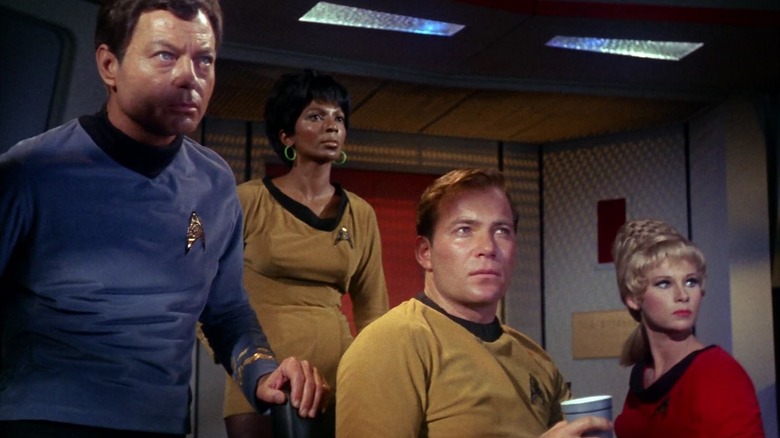The Lt. Uhura Secret Star Trek Creator Gene Roddenberry Hid From Paramount
The character of Uhura (Nichelle Nichols) wasn't in either of the original pilot episodes for Gene Roddenberry's "Star Trek." The first pilot, "The Cage" — which initially didn't air — didn't have any common characters with the "Star Trek" the public came to know, save for Spock (Leonard Nimoy). NBC asked Roddenberry to retool the series a bit, and he made "Where No Man Has gone Before," the first episode with Captain Kirk (William Shatner). The show was still set on the same U.S.S. Enterprise, and the sets were the same, but the characters were mostly all-new, and the tone a little lighter. "Star Trek" was a go.
The next episode in production order was called "The Corbomite Maneuver," and Roddenberry honed the show even further. "Corbomite" featured three additional new characters that would become regular members of the "Star Trek" ensemble: Dr. McCoy (DeForest Kelley), Yeoman Rand (Grace Lee Whitney), and Lieutenant Uhura (Nichelle Nichols).
It seems that the inclusion of Nichols in particular was somewhat contentious. Roddenberry had wanted to include a Black actor on "Star Trek," but, to sidestep the studio's casual 1960s-vintage racism, he kept the casting of Uhura a secret. Nichols recalled Roddenberry's clever subterfuge in a 1993 issue of Superstar Facts & Pix, noting that he waited until "Star Trek" had been approved before he started adding cast members. Indeed, Roddenberry went to NBC to ask, once "Where No Man Has Gone Before" was finished, if he could go back and, in his words, "add a little color." The phrase was vague enough that NBC said okay, assuming he was referring to costume design. Nichols was happy to have been cast, and appreciated Roddenberry's successful efforts to stymie systemic racism.
Gene Roddenberry waited until Star Trek was approved before casting Nichelle Nichols
It should be noted that Roddenberry already knew he liked Nichols, as the two had worked together on the TV series "The Lieutenant," a military show that Roddenberry had created in 1963. Nichols said that Roddenberry admired her work, and the two became friends (Nichols would later reveal in an autobiography that they were also romantically involved for a spell). The actress also said that Roddenberry wanted to deliberately attack the sexism and racism he regularly saw on TV, and hoped to cast Nichols as a means of inclusion. In her words:
"[Gene] was determined to change the face of television, to include all people, and get rid of as much sexism aas he could get away with. So he hired me and put me on the show. Nobody knew except his very close associates. The staff, the network, and the studio had no idea [...] He said to them, 'I'm going to make a change on the bridge, in the command crew.' He told them it wasn't a significant change. He just wanted to add a little color. They thought he meant wardrobe. And that's when the call went out, 'find Nichelle Nichols.' That's how we got away with it."
And, yes, the studio honestly thought that Roddenberry was talking about costumes. According to Nichols, NBC threatened to fire her and cancel her contract because of his subterfuge. "These people are no longer at [the studio]," she said, "so I can speak freely."
Nichols got a costume change anyway
Nichols also got to hear the story of how Roddenberry playfully threw the studio's perceived racism in their face. Evidently, they recalled his crack about adding "a little more color," and brought it up to his face:
"When they discovered what Gene was doing with that whole show, they tried to cancel it from day one. They said to him 'We thought you meant costume!' And Gene said: 'Oh, that's a wonderful idea. I don't like the green costume she's in anyway.' And he changed it to red."
Indeed, in "The Corbomite Maneuver," Uhura is seen wearing a golden Starfleet uniform, the color usually reserved for command officers on the original "Star Trek." The next time Uhura was featured, in the episode "Mudd's Women," she was in her signature red uniform, the color that indicates an engineer or a security officer. If one wants to extrapolate the color change into "Star Trek" canon, it would mean Uhura had changed career tracks. In actuality, though, the uniform shift was indicative of Roddenberry sticking it to the execs.
Famously, Nichols considered leaving the series but was contacted by Martin Luther King, who encouraged her to stay. A Black woman on a mainstream network TV series — and one possessed of military authority — was a rare sight in the mid-1960s, and King noted that she was a role model for many young Black kids watching. After a letter like that, naturally, Nichols felt compelled to stay. Uhura appeared in 68 episodes of "Star Trek" in toto, and would appear on "Star Trek: The Animated Series," and in the first six "Star Trek" movies. She passed away in 2022 at the age of 89, and the TV world lost a legend.


